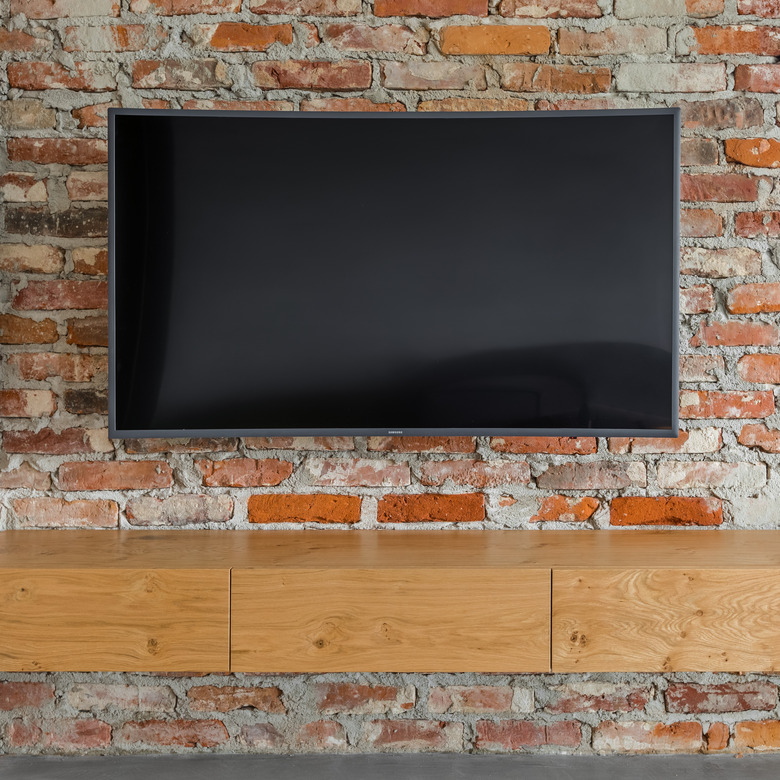How To Mount A TV On A Brick Wall
We may receive a commission on purchases made from links.
Mounting a flat screen television to a wall saves space, looks sleek, and gets it out of reach from the curious hands of a toddler or pet. However, the fasteners that work for flat screen TV installations on drywall don't work when it comes to concrete, masonry, brick, or stone. Whatever type of masonry surface you want to mount your flat screen TV on, you need special concrete or masonry fasteners to do so — otherwise, your new flat screen TV will be in pieces on the floor.
Tip
If the brick you're mounting your flat screen TV on is above a fireplace, check your warranty first. Many manufacturers do not honor warranties for TVs exposed to heat. Excessive heat can affect the sensitive electronics in your television.
Choose the Right Fasteners
Choose the Right Fasteners
Concrete, brick and masonry fasteners, like those for drywall, come in a variety of types and sizes rated by weight and use. You can choose from concrete screws, sleeve anchors, or toggle bolts for hollow bricks, all weighted for heavy-duty loads to support the mount that holds the flat screen TV.
Check the TV Weight Before You Buy a Mount
Check the TV Weight Before You Buy a Mount
Verify the weight of the television and choose a mount that can handle that weight. A universal mount rated for 125 pounds can generally handle 37-inch to 70-inch flat screen televisions. As an example, many 60-inch televisions weigh from 53 pounds to 76 pounds.
Things Needed
-
Shop vacuum or round wire brush
-
Hammer
-
Concrete sleeve or screw fasteners
-
Nut driver, screwdriver, or wrench
How to Mount a TV to a Brick or Stone Wall
How to Mount a TV to a Brick or Stone Wall
Before you begin any drilling, be sure to put on safety goggles and dust mask before you begin working, as masonry dust is not healthy to breathe or have in your eyes.
1. Drill Pilot Holes
Drill each pilot hole with a carbide-tipped masonry bit sized to the diameter of the concrete sleeve anchor or screw. Use a vacuum or round-wire brush to remove the debris from the pilot hole. Repeat this step for all the holes needed to secure the mount to the wall.
Tip
A hammer drill works best for drilling into masonry. You can rent hammer drills from home and rental centers. If you own a cordless drill, check it for a hammer drill setting.
2. Install the Anchor
The anchor installation will depend on what type of anchor you're using:
- Sleeve Anchor: Insert the sleeve anchor with the bolt and washer already inside it through the mount into the hole created. Repeat for all the sleeve anchors. Lightly tap on the bolt already installed. Tighten the bolt with the wrench. If you're using masonry screws, skip this step.
- Concrete Screw: Insert the concrete screw with a washer threaded on the screw through the mount into the hole. Slowly tighten the screw with a nut driver, screwdriver, or wrench into the wall. Do not over-tighten the screw or it will not work correctly.
- Toggle Bolt: Drill the hole through the hollow brick with a drill and masonry bit that is the same diameter of the toggle bolt. Repeat for all the holes needed for the mount. Thread the toggle bolt and washer through the hole in the mount and the brick by collapsing the wings of the bolt. Once the wings are inside the wall, they'll release against the inside of the brick. Pull back on the bolt to keep the wings flat as you tighten the bolt with a screwdriver or wrench, depending on head type.
3. Mount the TV
Install the flat screen television on the mount by securing it with the screws included in the mount. The back of the flat screen TV already has the holes for securing the mount to it with metal screws. Check to ensure the safety tabs are set for extra security.
Tip
- To determine the length of a sleeve anchor needed, add the minimum embedment requirements to the mount's thickness. For concrete screws, add the mount's thickness to a minimum of 1 inch and maximum of 1 3/4 inch for the proper screw length.
- Mark the depth of the hole on the bit with a piece of electrical tape so you don't drill the hole deeper than needed.
- Size the carbide drill bit to the size of the sleeve anchor. For example, use a 3/8- inch bit for a 3/8-inch diameter fastener. For concrete screws, use a bit slightly smaller than the screw; for example, a 3/8-inch screw requires a 5/32-inch bit, while a 3/16-inch screw requires a 1/4-inch screw.
